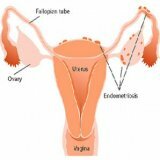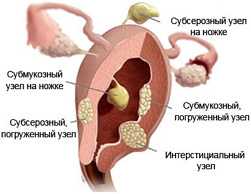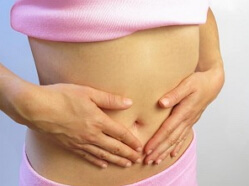Modern methods of treatment of endometriosis

Currently, the causes of the development of this disease are not fully understood, but experts have speculation that the development of endometriosis involves immune, hereditary and hormonal factors. Despite the fact that it has not yet been possible to establish the exact causes of the disease, modern methods of treating endometriosis exist, are widely used in practice and proved effective.
Symptoms and clinical picture of endometriosis
- pain during sexual intercourse;
- pain during menstruation;
- prolonged spotting spotting from the genital tract;
- pain during bowel emptying and urination;
- infertility.
Causes of development of endometriosis
As mentioned above, the exact cause is still unclear. Presumptive factors involved in the development of the disease:
- The phenomenon of "reverse"( retrograde) menstruation is a process during which a few menstrual blood during menstruation get through the fallopian tubes into the abdominal cavity. This process is observed in many healthy women, but strong immunity does not allow the endometrium to expand in the abdominal cavity.
- Another suggested cause is immune disorders. With weakened immunity, the risk of developing endometriosis increases, since cells of functional endometrium that, when retrograde menstruation, get into the abdominal cavity, do not collapse, but attach to other tissues and organs, forming foci of endometriosis.
- Heredity is another cause of the disease. If in the family one of the women suffered from endometriosis, then the risk of its development increases.
- Surgical interventions such as uterine scraping, abortion, cesarean section also increase the risk of developing.
- Hormonal factors affect the development of endometriosis. Especially when you consider that the endometrium responds subtly to estrogens, and the areas of endometriosis are sensitive to hormone changes. So female sex hormones contribute to the growth of foci of endometriosis.
Signs and symptoms
Endometriosis develops gradually, therefore, at first the symptoms are absent. However, there are signs that endometriosis can be suspected. These signs of a kind are a signal to further research, which will help to diagnose.
Common Symptoms of Endometriosis:
- Menstruation is accompanied by severe pain in the lower abdomen;
- Dysfunctional uterine bleeding;
- Pain in rectum during stool;
- Presence of blood in feces and urine during menstruation;
- Infertility. This is due to the fact that a large number of adhesions form between the pelvic organs, which close the lumen of the fallopian tubes, because of which the spermatozoon can not meet the ovum.
In endometriosis of the peritoneum( peritoneal endometriosis), an egg that enters the abdominal cavity from the ovary is destroyed there by the peritoneal immune substances, so it is not absorbed by the fallopian tubes.
Modern methods of treatment
The main goal of endometriosis treatment is to reduce pain, remove areas of endometriosis, and eliminate infertility. Endometriosis is treated with two methods: conservative and surgical. Sometimes these methods are combined.
Conservative treatment is used painkillers( non-steroidal anti-inflammatory drugs: paracetamol, aspirin), as well as hormonal drugs that suppress the function of the ovaries. Ovaries, in turn, produce estrogens that promote the growth of the endometrium. Thus, oppression of the ovaries will lead to a decrease in the growth of endometriosis.
Hormonal treatment is carried out by oral contraceptives. The composition of oral contraceptives includes female sex hormones, are in the form of tablets. For the purpose of contraception, these drugs are taken with a 7-day break, at which time menstruation occurs. And if you take them for the treatment of endometriosis, then you should drink them constantly, without a seven-day break for menstruation. This will create, albeit artificially, menopause, during which there will be no menstruation and the ovaries will not function.
Janine - oral contraceptive, is widely used for the treatment of endometriosis. This drug suppresses ovulation, helps reduce the size of foci of endometriosis. Ovulation is the process when an ovum leaves the ovary.
Danazol - a drug that is similar in structure to the male sex hormone. This drug depresses the work of the ovaries, delays ovulation, prevents the endometrium from expanding. This drug is prescribed by a doctor, who will determine the necessary dose. Danazol has side effects - weight gain, decreased voice, acne, increased hair loss, decreased mammary glands.
Similar gonadotropin-releasing hormone( Decapeptyl Depot, Zoladex) are drugs with a complex mechanism of action, leading to oppression of the ovaries and a decrease in the number of sex hormones.
Dekapeptil Depot and Zoladex are injections that are made for half a year every 28 days in the front wall of the abdominal cavity. The side effects of these drugs are the development of osteoporosis.
Progestogens, they are also called pregnancy hormones( Dyufaston, Charozetta) refer to hormonal drugs, which contain a small amount of progestogens, that is, pregnancy hormones. This drug, thanks to these hormones can suppress ovulation, reduce the number of female sex hormones that activate the growth of the endometrium.
Operative( surgical) therapies
As a rule, conservative treatment helps in the early stage of the disease, when the endometrial tissue is localized in small areas. If there was no timely treatment of endometriosis, and the disease developed into a later stage-spikes formed in the small pelvis, or "chocolate" ovarian cysts were observed, then a surgical method of treatment was used.
Usually, surgery is performed through small incisions on the anterior wall of the abdominal cavity with a laparoscope. Often after such intervention, a woman managed to become pregnant.
Also, if the expressed pains do not lend themselves to conservative treatment with tablets, then they resort to surgery, which is to remove the uterus.
Sometimes combine surgical and conservative treatment of endometriosis, with good results.



